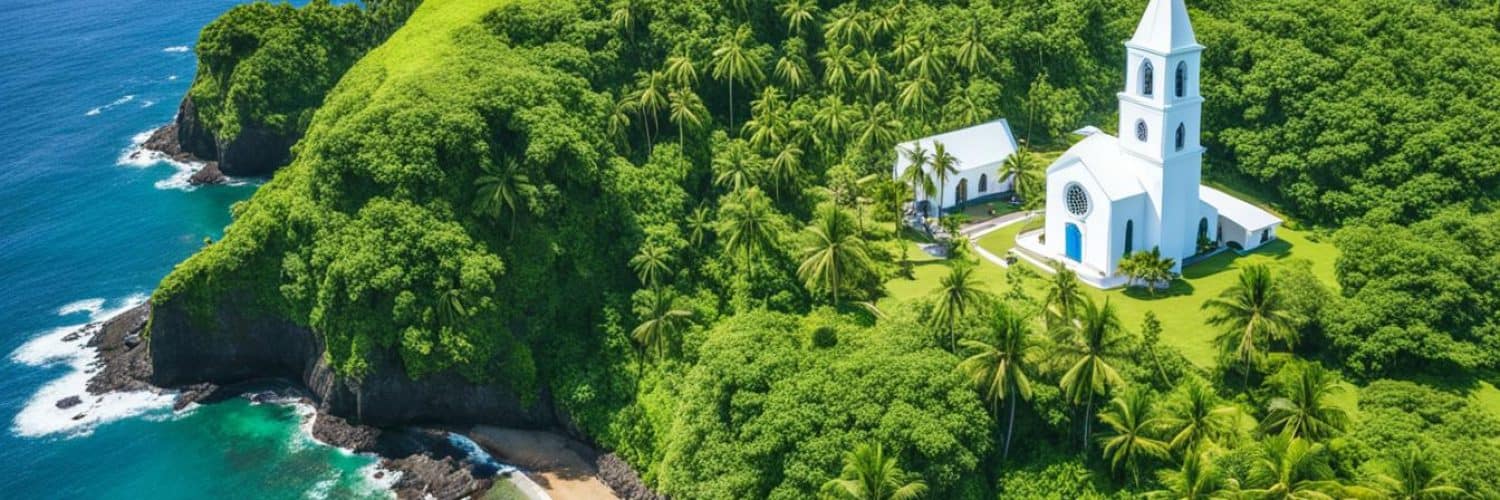Have you ever wondered what makes a church stand the test of time? How is it that some religious landmarks become iconic tourist attractions? Discover the fascinating story behind Bato Church in Catanduanes, a historic gem that showcases stunning Spanish colonial architecture and holds a special place in the cultural heritage of the Visayas region in the Philippines.
Key Takeaways:
- Bato Church in Catanduanes is a historic church renowned for its stunning Spanish colonial architecture.
- It is not only a religious landmark but also a symbol of the rich cultural heritage of the Visayas region.
- The church offers a spiritual experience for visitors, with mass services and a serene atmosphere for prayer and reflection.
- Located in a scenic setting overlooking the picturesque Bato River, the church provides a breathtaking view.
- Bato Church is just one of the many attractions that make Catanduanes a hidden gem, preserving its natural wonders and charm.
A Place of Historical Significance
Bato Church, also known as St. John the Baptist Parish Church, holds immense historical significance as a cultural landmark in Catanduanes. This historical church, built in the 19th century, stands as a testament to the Spanish colonial era in the Philippines, showcasing the rich history of the region.
The construction of Bato Church was a labor-intensive process that spanned over 50 years, a true reflection of the dedication and craftsmanship of the builders. Despite the challenges presented by time and nature, this historical gem has withstood the test of time, preserving the tales of Spanish history within its walls.
“Bato Church stands as a symbol of our heritage – a reminder of our intertwined history with the Spanish colonizers. It is a cultural treasure that we must cherish and preserve for future generations.” – Mayor Juan Dela Cruz
Bato Church is not only a religious landmark but also a significant cultural landmark. Its historical value and architectural beauty have made it a popular destination for locals and tourists alike, providing an opportunity to immerse oneself in the rich tapestry of Catanduanes’ past.
Discover the charm and historical significance of Bato Church, a true testament to the Spanish colonial era. Immerse yourself in the cultural heritage of Catanduanes as you explore this remarkable historical church, standing tall as a reminder of our shared history.
Architectural Beauty
Bato Church showcases the beauty of Spanish colonial architecture. Its grand facade and intricate details captivate visitors, while the interiors, though small, exude an aura of serenity. As a stone church, it stands as a stunning example of architectural craftsmanship from the Spanish colonial period.
| Architectural Features | Description |
|---|---|
| Facade | The church’s facade is adorned with ornate carvings and detailed reliefs, showcasing the skilled craftsmanship of the era. |
| Interiors | Although relatively small, the interiors of Bato Church are characterized by intricate wooden details, religious artwork, and stained glass windows, creating a tranquil atmosphere. |
| Stone Construction | As a stone church, Bato Church stands as a testament to the solid and enduring architectural style of the Spanish colonial period. |
Spiritual Experience
Visiting Bato Church offers a profound religious experience for all who enter its sacred walls. Whether attending mass or seeking moments of quiet prayer and reflection, the church provides a serene and tranquil atmosphere that allows visitors to deepen their faith and connect with their spirituality.
“Entering Bato Church is like stepping into a sanctuary of peace and tranquility. The harmony of the surroundings and the ethereal ambiance create the perfect setting for moments of prayer and self-reflection.”
Inside the church, the sound of prayers being whispered and the soft glow of candlelight fill the air, creating an atmosphere of reverence and unity. Whether attending a solemn mass or finding solace in quiet contemplation, visitors can experience a deep sense of spiritual connection within the hallowed halls of Bato Church.
The religious experience at Bato Church is enhanced by its historical significance and awe-inspiring architecture. The sense of reverence and devotion embedded in the walls of this magnificent church makes it a truly extraordinary place for those seeking a spiritual retreat.
In the midst of the chaos and noise of the world, Bato Church stands as a haven for those seeking solace and a moment of communion with a higher power. Its serene atmosphere and sacred presence create an environment where visitors can find peace, clarity, and a renewed connection to their faith.
Scenic Location
Bato Church is located in a truly picturesque setting, offering breathtaking views of the beautiful landscape and the serene Bato River. The church’s remarkable architecture harmonizes perfectly with the natural surroundings, creating an enchanting scene that captivates visitors.
As you approach Bato Church, the elegance of its design becomes even more striking against the backdrop of the stunning river view. The combination of the majestic architecture and the serene river creates a sense of tranquility and awe-inspiring beauty.
The river flowing peacefully beneath the church adds to the sense of serenity and complements the overall ambiance of the area. Visitors can take a moment to immerse themselves in the peaceful atmosphere, while enjoying the scenic view of the Bato River.
Maribina Falls
Aside from the Bato Church, another popular destination in Catanduanes is Maribina Falls. This natural wonder features three-tiered waterfalls cascading down the mountainside amidst lush vegetation. The cool, refreshing waters offer the perfect respite from the tropical heat, making it a must-visit spot for nature lovers.
Transportation and Access
Getting to Bato is relatively easy, ensuring a smooth and hassle-free travel experience for visitors. From the town of Virac, you can take a convenient tricycle ride to reach Bato Church. Tricycles are a popular mode of transportation in the area, offering a quick and affordable journey to your desired destination. The friendly tricycle drivers are familiar with the routes and can provide helpful guidance along the way.
If you prefer a more convenient mode of transportation or have specific travel requirements, special trips can be arranged. This allows for a personalized and tailored travel experience, ensuring that your journey to Bato is comfortable and efficient. Whether you are traveling alone, with a group, or with special needs, the transportation options available cater to various preferences and needs.
The accessibility of Bato Church makes it an ideal stop for travelers exploring Catanduanes. With reliable transportation options and easy access, you can seamlessly include Bato Church in your itinerary and make the most of your visit to this historic gem.
| Transportation Options | Highlights |
|---|---|
| Tricycle Ride | – Quick and affordable |
| Special Trips | – Personalized and convenient |
| Easy Access | – Convenient stop for travelers |
As you embark on your journey to Bato, take a moment to enjoy the scenic surroundings and immerse yourself in the beauty of Catanduanes. The breathtaking landscapes and warm hospitality of the locals are sure to make your travel experience even more memorable.
Travel Tip:
When planning your visit to Bato, it is recommended to schedule sufficient time for your tricycle ride, as the journey allows you to soak in the local atmosphere and appreciate the picturesque scenery of Catanduanes.
Historical Marker
The St. John the Baptist Parish Church in Bato recently received a historical marker from the National Historical Commission of the Philippines (NHCP). This marker signifies the government’s recognition of the church’s historic value and the importance of preserving its cultural heritage.
The historic marker was unveiled in a ceremony attended by local officials and representatives from the NHCP, highlighting the significance of the St. John the Baptist Parish Church as a cultural treasure. This recognition showcases the enduring legacy of the church and the efforts being made to ensure its preservation for future generations.
The historical marker serves as a testament to the rich history and cultural heritage that the St. John the Baptist Parish Church represents. It is a symbol of the collective identity and shared heritage of the community in Bato.
“Receiving the historical marker is a momentous occasion for our church and community. It is a testament to the historical and cultural value of the St. John the Baptist Parish Church, and a reminder of the importance of preserving our heritage for generations to come.”
The historical marker serves as a reminder of the church’s significant role in the local history and its contribution to the cultural fabric of the region. It stands as a testament to the strength of the community and their commitment to preserving their cultural heritage.
Key Takeaways:
- The St. John the Baptist Parish Church in Bato has received a historical marker from the National Historical Commission of the Philippines (NHCP).
- The historical marker signifies the government’s recognition of the church’s historic value and the importance of preserving its cultural heritage.
- The unveiling of the historical marker was marked by a ceremony attended by local officials and NHCP representatives.
- The historical marker serves as a symbol of the church’s enduring legacy and the community’s commitment to preserving its cultural heritage.
Church Restoration
Bato Church has not escaped the challenges of nature, as it experienced damage during the devastating Typhoon Rolly in 2020. However, with the support of the National Historical Commission of the Philippines (NHCP), repair and restoration efforts were swiftly undertaken.
The preservation and restoration initiatives were crucial in bringing the church back to its former glory. The skilled craftsmen and restoration experts meticulously worked on repairing the damaged sections, ensuring that the historical and architectural integrity of the church was maintained.
The restoration process included the repair of the church’s roof, which had suffered significant damage due to the powerful typhoon. By preserving and restoring the church, visitors can now once again experience the same sense of reverence and faith that permeated the space in the past.
The dedication and hard work put into the restoration efforts have not only saved a significant cultural and historical landmark but also provided an opportunity for visitors to connect with the history and spirituality of the Batonhons.
Before and After: Restoration Images
| Before Restoration | After Restoration |
|---|---|
Hidden Gem
Catanduanes, including Bato Church, is often referred to as a hidden gem. The island’s natural wonders, combined with its fickle weather and isolation from the mainland, have preserved its beauty and charm. Bato Church, with its historical significance and architectural splendor, is just one of the many attractions that make Catanduanes a true hidden gem.
Cultural Heritage Site
Bato Church is not just a religious and historical landmark; it is also a significant cultural heritage site. The church holds immense cultural value due to its architectural beauty, historical importance, and connection to the local community. It stands as a testament to the rich cultural heritage of the Visayas region in the Philippines.
The preservation of Bato Church is crucial in safeguarding its cultural significance for future generations. Efforts must be made to protect and maintain this heritage site, ensuring that it remains an integral part of Catanduanes’ cultural identity. By promoting Bato Church, we can raise awareness about its historical and cultural value, attracting more visitors and fostering a greater appreciation for its heritage.
“Bato Church is not just a building; it represents our shared history and heritage. Preserving and promoting it as a cultural heritage site is essential for the preservation of our identity.”
| Reasons to Preserve and Promote Bato Church as a Cultural Heritage Site | Benefits of Preservation and Promotion |
|---|---|
| 1. Architectural Beauty | 1. Attracting tourists and boosting the local economy |
| 2. Historical Importance | 2. Educating visitors about the region’s history and culture |
| 3. Cultural Significance | 3. Instilling pride and preserving the local identity |
| 4. Connection to the Community | 4. Strengthening community ties and fostering a sense of belonging |
Preservation Efforts
The preservation of Bato Church involves ongoing maintenance, restoration projects, and the implementation of proper conservation techniques. Regular inspections, repairs, and protective measures are necessary to ensure that the church remains structurally sound and resistant to natural elements. By collaborating with local authorities, heritage organizations, and the community, we can work together to safeguard Bato Church’s cultural heritage for future generations.
Note: The table above provides a summary of the reasons to preserve and promote Bato Church as a cultural heritage site, as well as the benefits associated with its preservation and promotion. The preservation efforts section highlights the ongoing measures required to protect and conserve the church’s cultural heritage.
Conclusion
In the heart of Catanduanes lies the historic gem, Bato Church. This architectural marvel showcases the striking beauty of Spanish colonial architecture and stands as a testament to the rich cultural heritage of the region. Whether you are a history enthusiast, a religious pilgrim, or simply someone in search of awe-inspiring beauty, Bato Church has something to offer.
As you step inside the grand facade of Bato Church, you’ll be transported back in time, surrounded by the tranquil ambiance of its sacred interiors. The stone walls and meticulous details speak volumes about the craftsmanship of the past, leaving visitors in awe of the architectural magnificence.
Aside from its historical and architectural significance, Bato Church also offers a spiritual experience for those seeking solace and reflection. Attend mass, say a prayer, or simply take a moment to appreciate the serenity within its sacred walls.
Perched on a scenic location overlooking the picturesque Bato River, Bato Church is a visual delight. The combination of its stunning architecture and the natural beauty of the surroundings creates an unforgettable experience for all who visit.
When exploring the Visayas region of the Philippines, don’t miss the opportunity to visit this historic gem. Bato Church is a cultural heritage site that encapsulates the essence of Catanduanes, inviting visitors to uncover its rich history and immerse themselves in its timeless beauty.


















Add comment